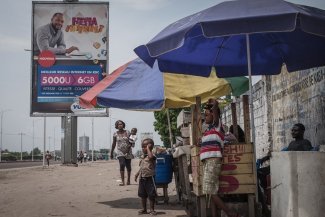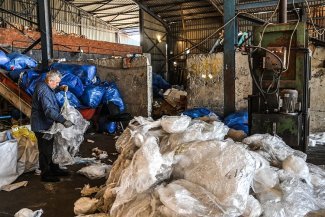Dr Shaina Mehra is an Indian psychiatrist who lives in Warsaw and works in a beautiful office where she counsels international patients. She has a close working relationship with Dr Ansari, a neurosurgeon who is also an Indian expat. Her ex-boyfriend, Devi has also come to Poland, where he works on a construction site. They all live a wonderful life in an exciting city. This may sound too good to be true, but it wasn’t for the screenwriters of the 2014 Bollywood blockbuster Kick, which was set and shot in the Polish capital. At the time it wasn’t far-fetched to set an Indian action rom-com in a country that only a year later would gain notoriety for its hostility towards refugees and migrants.
The nationalist Law and Justice party (PiS by its Polish acronym) came to power in October 2015, right at the height of Europe’s migrant crisis, and it was infamous for its anti-immigrant rhetoric. During the run-up to the elections, the leader of the party, Jarosław Kaczyński refused to take in any refugees at a time when the European Union was trying to settle 160,000 desperate people amongst European Union member states. Kaczyński warned that migrants carry “all sorts of parasites and protozoa, which…while not dangerous in the organisms of these people, could be dangerous here.” Poland is one of the most ethnically and religiously homogenous countries in Europe and this ‘Poland First’ rhetoric helped the party win 37.6 per cent of the vote against the then-governing Civic Platform (which only secured 24.1 per cent).
The next Polish parliamentary elections will be held on 13 October 2019. Despite being hit by high-profile scandals in recent months, and being in breach of EU law with its controversial judicial reforms, most pollsters expect PiS to repeat its 2015 victory, thanks to a combination of generous social spending, a booming economy and more benefits promised, including increased child benefits, better pensions and a higher minimum wage. However, rather than demonising migrants to ensure electoral success, this time the ‘enemy at the gate’ is ‘gender ideology’ – reproductive rights, sex education, gender equality and, most of all, LGBTI rights – which is seen as an existential threat to Poland’s Catholic family values.
“We are not dealing with a deep migration crisis. There are no crowds trying to reach Europe [as there were in 2015]. Therefore, the government cannot show dramatic images,” says Professor Antoni Dudek, a political scientist and historian at Cardinal Stefan Wyszyński University in Warsaw. “Besides, migration is an inconvenient subject for them.”
In 2017, Poland granted residency to 683,000 foreigners, according to Eurostat – one-fifth of all such permits issued across all the EU-28 member states and by far the biggest number for a single country. Eighty-seven per cent of those visas were for work. In addition, according to the OECD International Migration Outlook 2019, Poland has welcomed a record number of migrants in recent years: in 2017, with 1.1 million registered migrant workers, Poland was the world’s top destination for temporary migration, ahead of the United States.
They come from the east – and even further east
Despite receiving record numbers of labour migrants, Poland still needs more workers to power its booming economy – 1.5 million more by 2025, according to PricewaterhouseCoopers. In July, unemployment levels hit a record low at 5.2 per cent and 1.7 million Poles have migrated out of the country since it joined the EU in 2004, thanks to better pay and greater opportunities.
Over the years, Poland has traditionally looked towards its eastern neighbour, Ukraine, and to a lesser degree, other former Soviet states to fill its labour gaps. Today, there are an estimated two million Ukrainians living and working in Poland, mostly doing the low-paid jobs that Polish nationals won’t. The ‘cultural and ethnic similarities’ (read: a majority population that is white and Christian) of the two countries makes Ukraine the preferred source of guest workers.
But things are changing. For example, citizens of Ukraine, Belarus, Moldova, Russia, Georgia and Armenia can work without a work permit in Poland for up to six months every year. But since the EU granted Ukrainians visa-free entry (for business, tourism and visiting family and friends only) in 2017, they are increasingly moving westward to countries like the Czech Republic and Slovakia to take their chances working off the books in countries where they can earn better wages. And in 2020, when Germany plans to opens its doors to 25,000 extra non-EU migrant workers every year, Poland fears it will lose even more Ukrainian workers.
So now Poland is looking to south-east Asia to help fill its labour gap.
Any Polish employer who wants to hire a foreigner must first prove that the position cannot be filled locally before applying for a work permit (which is issued by the local authority and remains valid for up to three years). Most companies then pay one of the 8642 recruitment agencies hiring both temporary workers (hired directly by the agency and sent out on temporary assignments to different companies) and longer term workers (who are hired directly by a single company) to find workers, prepare the documents, organise the travel and train the workers in preparation to take up vacancies.
According to Michał Wysocki, an expert on immigration law, Poland’s blue-chip companies increasingly prefer to hire workers directly to: “Those employers who invest in importing a foreign worker from so far want to create a bond between them and a company so that they can stay in Poland and bring in their families over”.
The number of Asian workers in Poland is currently still small but this is expected to increase significantly in the coming years. According to data from the Ministry of Labour seen by Equal Times, the second highest number of work permits granted to a single country in 2018 went to 22,336 Nepalese workers (compared to the 262,461 permits granted to Ukrainian workers, and the 21,007 permits granted to workers from Belarus, the third largest number for a single country). In addition, 10,002 Bangladeshi workers and 9,706 Indian workers were granted work permits in the same year.
Vulnerable to exploitation
But the issuing of a work permit (which indicates that a company entrusts the execution of work to a particular worker, as well as the type of work to be performed) is only the beginning of the process – it doesn’t guarantee that an actual work visa (which must be applied for by the worker in his or her home country) will be granted or that the worker will actually start the job he or she has been recruited for. It is a lengthy process and business representatives claim that it can take up to 18 months before a migrant worker can fill a vacant position.
There are small numbers of foreign nationals from Africa and even smaller numbers from the Middle East who were granted work permits in 2018 (For example, 375 Ethiopians, 123 Ghanaians, 93 Nigerians, 46 Jordanians and 51 Lebanese according to statistics published by the Ministry of Labour and Social Policy), but existing recruitment networks in south-east Asia make the region an ideal source for qualified workers.
However, while low-paid migrant workers of all nationalities are vulnerable to exploitation, many Asian workers – who are far away from home, unable to speak the local language and saddled with stereotypes of being ‘hard-working’ – are in particular danger.
“Workers from Asia are solid, thorough and accurate, the result of their Asian upbringing,” claims a recruiter named ‘Jack’ from Gdańsk, pitching his services as a recruiter of workers from Nepal, Bangladesh and India on the jobs board of Lento.pl. “They are good at doing repetitive physical jobs, requiring manual skills, stamina and attention.” Jack offers companies a ‘try before you buy’ guarantee – if after a month, a labourer doesn’t meet the employer’s requirements, the company will get another worker without bearing any costs.
Equal Times also saw an advert from JDM Poland, a recruitment agency from Warsaw, advertising migrant workers on Gumtree as being “100% available and willing to work more than 200 hours per month”. According to the Polish Labour Code, as a rule, working time may not exceed an average of 40 hours in a five-day working week. The agency assures prospective employers that “overtime is at the same rate [of normal pay]”.
Grzegorz Sikora, communications director for the Trade Unions Forum (FZZ), tells Equal Times: “We are dealing with the next stage of the post-colonial world division”. While trade unions acknowledge that Poland needs migrant labour, the concern is that “the policy of hiring and the management of these workers does not meet European standards”. Social dumping, as well as the driving down of wages and working standards are all dangers that the unions are trying to prevent. “The further east Poland hires its workforce, the graver the problem becomes,” says Sikora.
Positives and challenges
But the hiring of overseas workers is unlikely to stop anytime soon, especially as business representatives are currently lobbying the government to ease the procedures for hiring migrant workers. The Polish embassy in New Delhi, for example, which covers India, Nepal and Bangladesh, currently has more visa applications than it can process.
As a result, many recruitment agencies are now pinning their hopes on workers from the Philippines to fill jobs in the IT sector and workers from Vietnam to fill vacancies in factories and construction. “When we take into consideration the needs on the market resulting from demographics, the emigration of Poles and the labour shortfall, Poland has no choice but to bring in workers from Asia,” says Grzegorz Tokarski, a private sector expert and CEO at Filipino Overseas Workers recruitment company.
And for the migrant workers who make it to Poland, new opportunities await a privileged few. Love brought Rahul Pathare, 35, to Poland from Germany, where he studied International Business. Originally from Mumbai, Rahul moved to Poland in 2016 to live with his now wife, Katarzyna, whom he met while studying in Freiburg.
The newlyweds settled in Uniejów, a small town about an hour north-west of Łódź, Poland’s third largest city. Rahul works at an advertising agency in Warsaw during the week and comes home to his wife and two-year-old daughter Sara at the weekends. “I feel good in Poland,” he tells Equal Times. “I have a great job, a house and a family here.”
Latika Bhardwaj has had a tougher time. “Poland is not used to brown and black immigrants,” says the 26-year-old invoice analyst who came to Poland from Auckland a year ago for work. “I am not saying all Polish are racists,” but she does say that she has encountered some hostility, particularly in shops, which she attributes to her skin colour. According to new research from the OSCE Office for Democratic Institutions and Human Rights (ODIHR) and the Commissioner for Human Rights of Poland, hate crimes against migrants (specifically those from Africa, the Ukraine and those who are visibly Muslim, or assumed to be) are chronically under-reported in Poland. And every year, the annual March of Independence, organised by nationalist and far-right groups on 11 November to commemorate the country’s independence, is marred by incidents of racist and xenophobic chants and violence.
But Latika won’t let this stop her from making a life in Poland. “Why should I leave this country? In New Zealand, I worked below my qualifications. I’ve always wanted to have a job related to business and French, and I’ve found it here. You will find such people [racists] everywhere. You cannot make decisions because of them,” she says defiantly.









